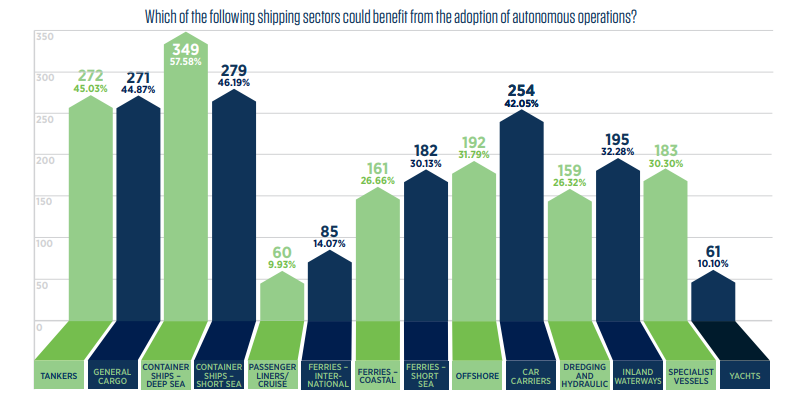IMarEST issued a survey on a number of issues surrounding the adoption of remote and autonomous technology in shipping. The report shows it is very likely that the adoption will proceed on a sector by sector basis, but it is still unclear as to the justifications for the business case for each of these sectors in terms of full adoption.
Key findings
- 85% of those surveyed agreed that seafarer skills will remain an essential component in the long term future of the shipping sector.
- Turning to the challenges of adoption of remote and autonomous operation, only 15.5% of survey respondents think that the shipping industry is currently ‘geared up’ to support the implementation of remotely operated or autonomous vessels
- Over 64% of the survey respondents purported the view that currently there are too many barriers to see significant adoption of remote and autonomous operations
- Two-thirds of survey respondents agreed that autonomous technology could create a competitive advantage for some shipping companies on a sector by sector basis.
- Whilst only 15.5% felt that the shipping industry is geared up for autonomous and remote operation technology at present, a much larger percentage could see the longer term benefits.
- Furthermore, just over half thought that autonomous technology could create cost savings for the industry.
- Among the various vessel types, the survey results indicated that cargo transport was the most likely to benefit from remote and autonomous operation

‘Autonomous technologies could create a competitive advantage for shipping companies, but adoption will vary significantly between market segments’, was one conclusion reached in an industry-wide investigation conducted by the IMarEST’s Marine Autonomous Surface Ships special interest group (MASS-SIG). An initial survey went on to inform a roundtable discussion which in turn formed the basis of a report: “Autonomous Shipping – Putting the Human Back in the Headlines”.
While only one in six believe that industry is fully geared up to exploit the autonomous or remote operation of commercial vessels in the immediate future, the general sentiment was that such technologies will deliver benefits over the long term. However, somewhat ironically, the success of unmanned ships will hinge ultimately on accommodating the human-in-the-loop.
More holistic discussion, data, and collaboration of technology will need to be disclosed and understood in more detail. There needs to be a clear, compelling business and safety cases to show industry that autonomous shipping will help to generate more revenue/reduce costs and make operations safer. This is currently lacking.
These are the first gentle steps in a long and difficult journey to understand the impacts to the industry and answer questions so as to measure the changes required in workforce capability, competency and training requirements to ensure that the human remains highly effective, which sits ironically in the context of the autonomous ship.
Our findings appear to suggest that the human will remain an essential component in the long term future of shipping, even if that future is autonomous.
MASS-SIG’s investigation blended quantitative analysis in the form of a online survey with qualitative analysis of the results in a roundtable discussion held during Singapore Maritime Week in April, with the support of BMT Defence and Security and Braemar, as well as the British Chamber of Commerce (Singapore) and the Institution of Mechanical Engineers.
The survey, with more than 600 responses, sought opinion on the drivers for autonomous technology; the business case for automation and remote operation; amenability to such solutions by vessel segment; the relationship between man and machine, and by extension the human element; societal acceptance; and workforce succession planning.
Building a better understanding of the impacts is necessary so as to measure the changes required in workforce capability, competency and training requirements so that those charged with managing and ensuring the safe operation of automated vessels are as effective as they can be.
Recommendations: Skills and Education Gaps
- Map functions of the digital ship to skills required (research tasks v’s functions)
- Develop a framework for training courses aligned to the future roles and functions of sea and shore based operational personnel
- Engage with training providers and share the future skills requirements
- Provide on-the-job training now for seafarers to build cross-skilling opportunities in order to gear up and Shipping companies for future technology changes, helping them to “become relevant”
- Help seafarers to become relevant and maintain up-to-date knowledge to support them in the future
- Capturing knowledge of senior officers on-board is key. Industry should make sure that the knowledge is companies captured to support the next generation as senior officers and millennials are developing different skill sets.
- Shore-based staff need to have a plan for development as well. With many of the shore-based operational staff being ex-seafarers, they will need to have a succession plan
Explore more herebelow:































































